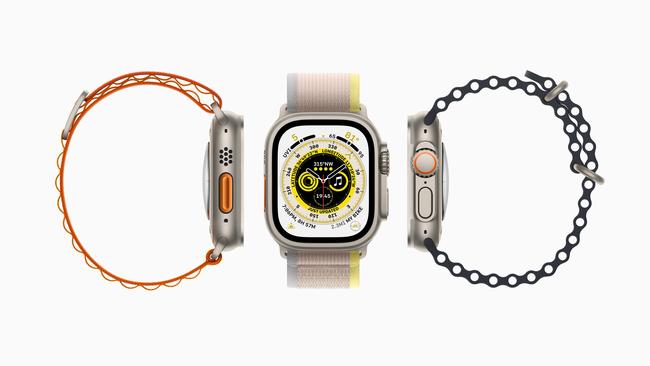Apple Watch ‘now ready for enterprise’
Not content with selling just to consumers, the tech giant is ramping up deals with Australian energy companies and city councils.
Tech giant Apple is spruiking its smartwatch in the enterprise space, selling the devices to Australian energy companies, city councils and other businesses in a bid to swipe market share from rivals including Samsung and Garmin.
The market share grab comes as it readies a major product event in the US next week.
Apple Watch is one of the company’s most successful products and has made it the world’s biggest smartwatch vendor, accounting for an estimated 34 per cent of all smartwatch shipments in 2022 and 60 per cent of revenue for the entire market globally, according to data from Counterpoint.
In a bid to further increase its market share, Apple is now ramping up its local enterprise deals and is encouraging uptake of its Watch across factory and office floors, and out in the field.
Jeremy Butcher, Apple’s product marketing executive in charge of enterprise and education, said in an interview that Apple’s ‘Mobile Device Management’ program, or MDM, will be made available with WatchOS 10, letting businesses remotely control devices, install and remove apps, access corporate VPNs and configure accounts like they would a company laptop or iPhone.
“I think it’s very similar to the iPhone, where we made an iPhone for everybody and then CEOs said ‘hey, I really want to use this for work’,” Mr Butcher said.
“Over the last few years we’ve added all sorts of capabilities both in health and safety, but also in communication and the platform for apps, that it really has led to this moment where enterprise customers are seeing more and more connections, and have started putting them into practice.”
Logan City Council claims it has saved $70,000 over three years after it replaced its traditional pendant duress devices worn by plumbers, electricians and local law officers with Apple Watches.
Endeavour Energy meanwhile rolled out Apple Watch to 120 of its employees in 2021 and introduced a ‘close your rings’ challenge right away, with 73 per cent saying the device made them more active. Some 77 per cent of workers took action after receiving high noise alerts, with hearing impairment is one of the company’s most common occupational injuries and highest-cost workers’ compensation claims.
The energy firm has since deployed an additional 450 devices to its remaining field workers and is considering providing Apple Watch to office workers as well.
“Most of our customers go to work. And our goal really is to make the best products and unlock the potential of our people,” Apple Watch product manager Eric Charles said.
“And so if Apple Watch can enable an enterprise customer or someone who’s just trying to go to their job and be a productive employee, while at the same time staying healthy, I think that that ticks off a lot of points for us.”

The council said the Apple Watch represented a major upgrade from the pendant devices, which were often uncharged or left on desks.
Apple doesn’t release sales figures but is estimated to own around 49 per cent of the Australian smartwatch and fitness tracker market, with Fitbit in second place with 28 per cent.
Apple is expected to unveil its next-generation iPhone next week on September 12, which is widely tipped to feature USB-C charging after laws passed in the US requiring phone manufacturers to adopt a common charging connection by 2024.
Pundits are also expecting a larger version called iPhone 15 Plus, a pricier model called iPhone 15 Pro and a bigger version of that model with a more advanced camera, called iPhone 15 Pro Max. The company may also unveil new Apple Watches, as well as a USB-C Airpods Pro case.
The higher-end iPhone 15 Pro models are widely expected to be equipped with a titanium frame instead of a stainless-steel frame, according to analyst Ming-Chi Kuo, who said the devices would likely weight less than iPhone 14 Pro models.
He said the iPhone 15 and iPhone 15 Plus will be available in black, pink, yellow, blue, and green, and that production issues related to the iPhones’ titanium frame, display panels, batteries, and a new stacked camera sensor for the lower-end iPhone 15 and iPhone 15 Plus had all been resolved.
The four models should be equipped with USB-C ports and the ‘dynamic island’, with the Pro models rumoured to receive a faster A17 Bionic chip, a customisable Action button, Wi-Fi 6E support, and more.
The new devices should be able to be preordered a few days after the September 12 event.





To join the conversation, please log in. Don't have an account? Register
Join the conversation, you are commenting as Logout